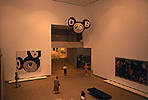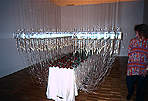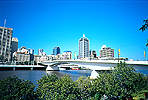
|
|
Jan. 28, 1997
|
Art Watch Index - Jan. 21, 1997
![]()
<<Jonas Mekas - Frozen Fim Frames>>
Filmography for Jonas Mekas http://us.imdb.com/M/ person-exact/Mekas, %20Jonas
Reminscences of a Journey to Lithuania(1972)
John Lennon
Filmography for
Filmography for
|
"Paradise Lost Always Already", or Jonas Mekas's Moving Picture
Reminiscence If there is a place in which things that appear like illusion, in uncertain forms within flickering light, can someday settle down as if that behavior was a principle established from long before, from the times of the origin of the world, there is no wonder in someone saying that that place is a paradise called "reminiscence". When one remembers that the word used for "memory" in "Reminiscences of a Journey to Lithuania" (1972) was "reminiscence(s)", it is self-explanatory that that "paradise" is certainly referring to the Platonic idea of the "memory about the previous life known by the soul". The way a "paradise" is understood by Mekas, himself, in "'Paradise Not Yet Lost', or 'Oona's Third Year'" (1979), is a time which is not remembered anymore by Oona when she grows up, as well as the Lithuanian countryside where Mekas spent his boyhood and Oona also spent some time, thus the movement intended by the film is to establish the reminiscences which will occurr eventually, in advance. Putting such thoughts into a movement in the film which is constantly in the present, whether shooting or watching it, is quite an "anachronistic" act, and it does not seem suitable for someone who criticizes the Hollywood movies, which feeds itself on the temporal expression that is systematically controlled, as fabrications. However, since there is no ground to declare that "the creator is an existence who does not know his own ecriture" (Yasuo Ishimitsu), the strange attraction emitted by Mekas's film must be described as something located at a distance from the "creator's" word. Return The privileged "figure" of a reminiscence is return, and that is probably the general custom of travel of a return trip to/from Lithuania, the psychological consent of people gathering to remember the now absent John Lennon (as a form of a reminiscence), or the return to nature of the seasons where it starts and ends in snow in 'Oona's Third Year'. In other words, Mekas, who describes himself as a "filmer" and not a "filmmaker" (déjà-vu bis. No. 2), creates films which represents various subjects of return in a very honest or rather vulnerable way. If one develops the same thing which returns chronologically, it becomes a typical "story", and needless to mention the gang in a Yakuza film, a screwball comedy has been building up its rich assets in the form of a husband-and-wife fight, and the melodrama, in the form of departure and coming home, and Mekas, who has been repeating the subject of return without recognizing, can actually be described as an excellent story-writer. The meaning of this is very important. That is because it means that Mekas's film is related to the lineage of American movies. It is true that Mekas's movie is made from fragments, and that the instability (of the camera) and the lack of lighting stand out. However, if one places his film next to that of Sergei Eizenshtein's, the affinity towards the story, or to be more exact, towards the economy of a type of story-telling, is obvious. "In a Western movie, someone comes from somewhere, pushes the bar swing-door, and in the ending, disappears somewhere. What is expressed there are merely fragments of a person, but strangely enough, those fragments have a power to make people believe that they have lived the whole of a story. That is where the power of the Americans lie. Others cannot do the same" (Jean-Luc Godard). Encounter At the end of "'Paradise Not Yet Lost', or 'Oona's Third Year'", there is a scene where "Nicholas Ray, in the year he dies with cancer", walks along the snowing pavement, walks past, looking down withoug even glancing towards the camera that is taking him. The fact that Mekas lived the same age as John Casavetes means that his fight with his idea of "Hollywood" was different from that of Ray's age. When Godard says, "Americans can thrust their own stories to people in other countries of the world", rather than referring to real Americans, the "Americans" mentioned here, like the "Hollywood" mentioned by Mekas, is an existence that forever gloomily clings because it is an abstract idea. Although having qualities of being an excellent story-writer, Mekas, who, although simple, endeavours a resistance towards story-telling, is an ethical existence as surmised. Trying to record what probably will be lost so much in the future that one cannot remember, reminds us of the French psychoanalyst, who was forced to utilize the pre-futuristic form in order to translate what he described as the "real thing" into language. Maybe Mekas has realized that since that "real thing" made repetition possible as an origin because it was "always already" lost, in a film, the present which moves "now/here", could have been something which was lost "always already". [Yuzo MORITA/Film Critic]
|
|
|
|
Asia-Pacific Triennial of Contemporary Art

The "balloon" floating in the most prominent space of the exhibition hall is by Takashi MURAKAMI, one of the 5 participating Japanese artists. Named, "Mr. Dob", the comic-like character may be a symbol of Japanese sub-culture. The painting on the bottom right by Yasumasa MORIMURA is a parody of famous Western paintings.
A work by Yukinori YANAGI familiar to the contemporary art fans, consisting of a colored sand painting of a national flag in a clear plastic box, which is destroyed by the ants released inside. Many visitors who saw the work wrote that it is "cruel to the ants" in the notebook set at the exhibition site. The selection of the Japanese artists was jointly done by Fumio NANJO, an independent curator, and the Australian curator.
One of the most impactful works was by Chen Yanyin (female) from China. A work consisting of a bright red rose taking intravenous injection. The title is "Discrepancy between one idea".
Kamin Lertchaiprasert from Thailand made objects of animals and people made from kneaded newspaper, and lined up more than 300 of them. They express the many social issues taken up in the newspaper. The work in the back is a platform for pole jumping, which is part of a display by Kim Myung Hye from Korea, titled, "Driving up to the limits". It can be taken as a criticism towards Korea's policy of placing priority on economic growth.
A female artist, Destiny Deacon who is a descendent of the indigenous aborigines, recreated her own living room in the gallery. She appealed her existence which receives discrimination as a minority.
Yun Suk Nam from Korea displayed a pink sofa with a sharp edge sticking out from it. A feministic criticism towards her country's conventionalities can be discerned.
A view of downtown Brisbane from the Queensland Art Gallery. Photographs: Satoru NAGOYA
Asia-Pacific Triennial of Contemporary Art http://www.slq.qld.gov.au/ qag/apt/welcome.htm
Queensland Art Gallery
Pauline Hanson Homepage
The unofficial Pauline Hanson Web Site
Pauline Hanson
Pauline Hanson - Caught in the Web
Profile: Yasumasa Morimura
Yasumasa Morimura - Reference Page
|
Asia-Pacific Triennial of Contemporary Art
Brisbane, the state capital of Queensland, located in the northeastern part of Australia, with a population of some 1.5 million, is the third largest city in the country. Skyscrapers stand in this downtown area which is surrounded by a meandering river. At this time of the year, in mid-summer, lightly clothed local citizens and tourists stroll down the shopping mall in the center of the city, making the mood all the more tropical. In Brisbane, an international art exhibition, titled the "Asia-Pacific Triennial of Contemporary Art", was established in 1993. The event is sponsored by the Queensland Art Gallery, located at the center of Brisbane city, and this gallery also serves as the venue. "Triennial" means an exhibition held once in three years (the word "triennare" in Italian may sound more familiar), and it is a huge event to introduce contemporary art from the Pacific basin including Australia and New Zealand, the East Asian nations such as Japan, Korea, and China , and the Southeast Asian countries. This year's second triennial started from September 27th and runs through January 19th. This time, the exhibition added four more countries and regions, such as India and New Caledonia, and in total, more than one hundred artists from seventeen different countries and regions exhibited their works. Why in Australia? The photographs will offer an idea of the kind of works that were displayed, but they may not explain why an event of such scale was realized under the theme, "Asia-Pacific", in Australia today. In Japan, the recent increase of exhibitions introducing Asian contemporary art indicate something like an "Asian boom". Of course, such a phenomenon can also be seen outside of Japan, where exhibitions of art from non-Western regions, such as Asia and Africa, are held in line with the recent trend focusing on "the review of modernism" and "multi-culturalism". The opening of this triennial happened to coincide with an "incident" that occurred at a perfect timing with this event, which turned out to be an interesting indicator in measuring the "expectations" of the Australians, who were involved in the realization of this exhibition. In Sepetmeber of 1996, Pauline Hanson (female), a new independent member of the Lower House of the Australian Parliament, said in her first speech at the Parliament, that "The Australian government over-priviliges the aborigines (indigenous people), and that "Many immigrants are Asian and there is a fear that Australia will be full of Asians", and she was under fire for "being racist". However, on the other hand, it is also a fact that some analyses hold that many people, especially among the Caucasian Australians in and below middle class, have the same kind of idea as Parliament member, Hanson, and as a result, this surfaced the hidden predicament of this country, which is endeavouring the transition from the previous "Caucasian-centered Australia" to the "multi-cultural Australia". The international art exhibition as a "policy" Apart from the recent emergence of multi-culturalism in the art world, in order for Australia to sustain its presence in the Asia-Pacific region, she needs to deepen her relationships with the Asian countries, and actively accept more immigrants from Asia, to expand her economic scale. The "multi-culturalism" Australia encourages, is an important policy that decides the future of the country, and thus in that context, the political role assumed by the "Asia-Pacific Triennial", cannot be ignored. The opening ceremony of the triennial was attended by the premier and the deputy premier of the state of Queensland, to emphasize the significance of the triennial as the "place for the dialogue with the Asian nations" (Doug Hall, director of the Queensland Art Gallery), to the artists, curators, and journalists from the participating countries, who filled the big concert hall adjacent to the triennial site. In the ceremony, ethnic dances of the aborigines and the islandsin the Pacific were performed to impress how much the "Caucasians" respected the non-Caucasian cultures. "Message Art" and the Japanese artists The selection of artists from each country was done in a "democratic" way, in which a team of curators from Australia and their counterparts from each participating country held discussions for the choice. Artists from Australia and the Asian countries responded well to this consideration, and their responses could be seen in the works that loudly expressed the ideas such as their existence as a minority member, the individuality of their country's custom, culture, and history, and the problems that their nation held. In the current situation, where contemporary art can only exist by surpassing the pursuit of plastic art and carrying a certain message, only the works of the Japanese artists seemed to remain silent with an introverted presence, and there is some doubt whether this is something that we can feel proud of. [Satoru NAGOYA/Art Journalist]
|
|
|
|
|
|
|
|
|
Jan. 28, 1997
|
[home]/[Art Information]/[Column]
Copyright (c) Dai Nippon Printing Co., Ltd. 1997
Network Museum & Magazine Project / nmp@nt.cio.dnp.co.jp





